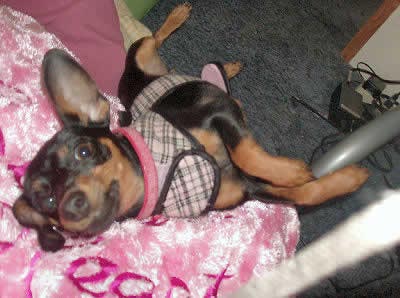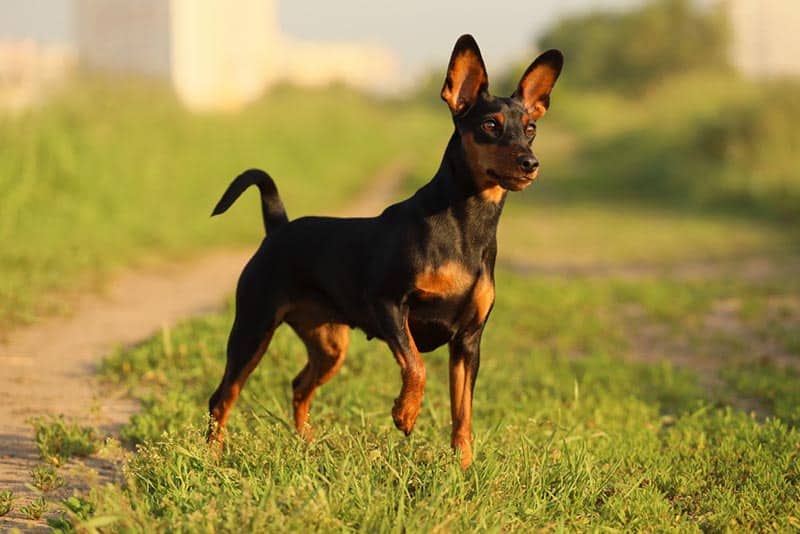
Contrary to popular belief, the Miniature Pinscher is not a descendent of the Doberman Pinscher!
Though it is not known how old the Miniature Pinscher is, it is known that it a much older breed than the Doberman Pinscher. It is said to be the result of a cross between a smooth-coated Dachshund and an Italian Greyhound, and may have been a model for the development of the Doberman Pinscher. It is classified as a Toy breed but was originally used as a working dog on farms.
The Miniature Pinscher, also referred to as the Min Pin or Mini Pinscher, is a courageous, proud and independent breed with a high sense of loyalty. These dogs are very alert and energetic. They are also highly intelligent, and they learn to understand and obey commands quickly. They are good with considerate children, and can get along well with strangers and other dogs if well socialized. Being sensitive to cold, but small in size, makes them a good candidate for an apartment. They love to play with toys, and will also enjoy a daily walk. They make fine watchdogs and ratters.
When selecting a Miniature Pinscher, check bloodlines for progressive retinal atrophy, an eye disease that can cause blindness. Also look for signs of luxating patella.
- Kingdom: Animalia
- Phylum: Chordata
- Class: Mammalia
- Order: Carnivora
- Family: Canidae
- Genus: Canis
- Species: lupus familiaris
Common Name(s)
Miniature Pinscher, Min Pin, Mini Pinscher, and Zwergpinscher
Breed Type
The Miniature Pinscher is classified as a toy breed, but was originally used as a working dog on farms. Contrary to popular belief, this breed is not a descendent of the Doberman Pinscher.
Background
It is unclear just how old of a breed the Miniature Pinscher is. Its likeness can be found in centuries-old paintings and sculptures, but the first known documentation was produced in 1836. This documentation states that the Miniature Pinscher is the result of a cross between a smooth-coated Dachshund and an Italian Greyhound. It is known that this breed is far older than the Doberman Pinscher, and it may have even been a model for the larger breed’s development.
Description
The Miniature Pinscher is a small dog with a compact and muscular build. It has dark eyes and upright ears, which may or may not be cropped. The muzzle is of medium length. The tail is docked where permitted. Its short, sleek coat may be red, black and tan, or chocolate and tan. A blue coat is also recognized by the AKC, but it cannot be shown.
Male Min Pins are 10 to 12 inches tall and weigh 8 to 10 pounds. Females are 10 to 11 inches tall and weigh 8 to 9 pounds.
Care and Feeding
The best foods for the Mini Pinscher include pork, beef, wheat, potatoes, yellow corn and beet pulp. It is important not to overfeed this breed, because they could become overweight. Regular combing and brushing are all that is needed to maintain the easy-care coat of the Min Pin. Baths should be given only when needed.
The Miniature Pinscher’s ears may be cropped, and tail cropping is required by the AKC. Front dewclaws should also be removed. These procedures are done during the first week of life.
Miniature Pinschers need annual checkups. Vaccinations should be administered on the following schedule:
- 6-8 weeks: Distemper, Leptospirosis, Hepatitis, Parainfluenza, Parvo, and Corona virus (DHLPPC)
- 10-12 weeks: Second DHLPPC
- 14-16 weeks: Third DHLPPC and rabies
- Annually: DHLPPC and rabies booster
Min Pins shed moderately. Regular vacuuming of the carpet and furniture will be necessary.
Housing Your Dog
Mini Pinschers make good indoor dogs. They do not need a large yard to get in their exercise requirements. This breed is sensitive to cold weather, so it will need a sweater when the temperature drops. Min Pins love to play with toys, but they have a tendency to chew on them. Therefore it is important to examine and replace them regularly so that the dog does not swallow small pieces.
Social Behaviors
The Miniature Pinscher does well with considerate children, but is not recommended for smaller ones. It can do well with other dogs and strangers if well socialized.
Handling and Training
Miniature Pinschers can be rather headstrong, so it is important to be firm and consistent in their training. But once you’ve established yourself as the leader of the pack, these dogs are quick learners. They are good at competitive obedience, agility and watchdogging.
Activities
These active little dogs take care of most of their exercise needs through normal play. However, they still need a daily walk. If allowed to play outdoors, it is important to keep them inside a secure fence due to their natural curiosity and escape skills.
Breeding/Reproduction
When selecting a mate for your Min Pin, check bloodlines for progressive retinal atrophy and joint problems.
Common Health Problems
The Miniature Pinscher is a very healthy breed that rarely has serious problems. They often live 15 years or longer. It is important to have the eyes checked regularly. Progressive retinal atrophy, a somewhat common disorder in the breed, can eventually cause blindness.
Availability
Miniature Pinschers are reasonably easy to find in most areas. Prices average $400 to $700.
References
“Miniature Pinscher“, Dog Breed Info Center, Copyright 1998-2008
Cusick, William D., “What to Feed a Miniature Pinscher“, Referenced online, 2008
“Miniature Pinscher Puppies for Sale“, Copyright PuppyFind.com, LLC, Referenced online, 2008
“Miniature Pinscher Health Management“, The Fusion Network LLC, Copyright 2008
“Miniature Pinscher“, Wikipedia, Copyright 2008
Featured Image Credit: Sevostyanova Tatyana, Shutterstock
